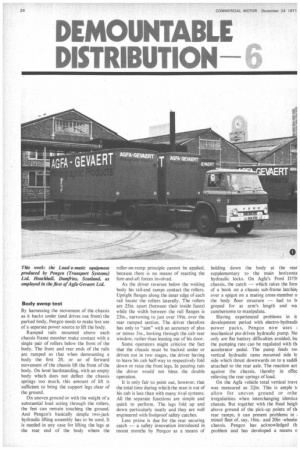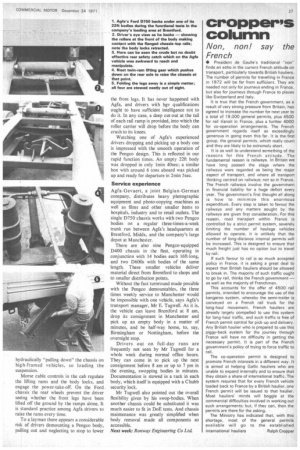DEMOUNTABLE
Page 28

Page 29

If you've noticed an error in this article please click here to report it so we can fix it.
DISTRIBUTION Body swop test By harnessing the movement of the chassis as it backs under (and drives out from) the parked body, Pengco needs to make less use of a separate power source to lift the body.
Ramped rails mounted above each chassis frame member make contact with a single pair of rollers below the front of the body. The front and rear ends of the rails are ramped so that when demounting a body the first 2ft. or so of forward movement of the chassis lift the front of the body. On level hardstanding, with an empty body which does not deflect the chassis springs too much, this amount of lift is sufficient to bring the support legs clear of the ground.
On uneven ground or with the weight of a substantial load acting through the rollers, the feet can remain touching the ground. And Pengco's basically simple two-jack hydraulic lifting assembly has to be used. It is needed in any case for lifting the legs at the rear end of the body where the roller-on-ramp principle cannot be applied. because there is no means of reacting the fore-and-aft forces involved.
As the driver reverses below the waiting body his tail-end ramps contact the rollers. Upright flanges along the inner edge of each rail locate the rollers laterally. The rollers are 25in. apart (between their inside faces) while the width between the rail flanges is 23in.. narrowing to just over 19in. over the rear ramped section. The driver therefore has only to "aim" with an accuracy of plus or minus 3in., looking through the cab rear window, rather than leaning out of his door.
Some operators might criticize the fact that the chassis must be backed under or driven out in two stages, the driver having to leave his cab half-way to respectively fold down or raise the front legs. In pouring rain the driver would not bless the double operation.
It is only fair to point out, however, that the total time during which the man is out of his cab is less than with many rival systems. All the separate functions are simple and quick to perform. The legs fold up and down particularly neatly and they are well engineered with foolproof safety Catches.
Less praise is due for the rear securing catch — a safety innovation introduced in recent months by Pengco as a means of holding down the body at the rear supplementary to the main horizonta hydraulic locks. On Agfa's Ford D75I chassis, the catch — which takes the torn of a hook on a chassis sub-frame latchinl over a spigot on a mating cross-member o the body floor structure — had to 131 groped for at arm's length and wa cumbersome to manipulate.
Having experienced problems in it development period with electro-hydraulii power packs, Pengco now uses mechanical pto-driven hydraulic pump. No only are flat battery difficulties avoided, bu the pumping rate can he regulated with th accelerator pedal. The pump feeds twi vertical hydraulic rams mounted side tr. side which thrust downwards on to a saddl attached to the rear axle. The reaction act against the chassis, thereby in effec relieving the rear springs of load.
On the Agfa vehicle total vertical trave was measured as 2iin. This is ample ti allow for uneven ground or othe irregularities when interchanging identica chassis. But together with the fixed heigh above ground of the pick-up points of th rear ramps, it can present problems in ; mixed fleet of, say, 16in.and 20in -wheele chassis. Pengco has acknowledged th problem and has developed a means hydraulically "pulling down" the chassis on high-framed vehicles, so loading the suspension.
Morse cable controls in the cab regulate the lifting rams and the body locks, and engage the power-take-off. On the Ford chassis the rear wheels prevent the driver seeing whether the front legs have been lifted off the ground by the ramps alone. It is standard practice among Agfa drivers to raise the rams every time.
To a layman there appears a considerable risk of drivers demounting a Pengco body, pulling out and neglecting to stop to lower the front legs. It has never happened with Agfa, and drivers with hgv qualifications ought to have sufficient intelligence not to do it. In any case, a deep cut-out at the tail of each rail ramp is provided, into which the roller carrier will drop before the body can crash to its knees.
Watching one of Agfa's experienced drivers dropping and picking up a body one is impressed with the smooth operation of the Pengco design. This is reflected in our rapid function times. An empty 22ft body was dropped in only Imin 40sec; a similar box with around 6 tons aboard was picked up and ready for departure in 2min 5sec.
Service experience Agfa-Gevaert, a joint Belgian-German company, distributes heavy photographic equipment and photo-copying machines as well as films and other smaller items to hospitals, industry and to retail outlets. The single D750 chassis works with two Pengco bodies on a regular three-times-a-week trunk run between Agfa's headquarters at Brentford, Middx. and the company's large depot at Manchester.
There are also nine Pengco-equipped D400 chassis in the fleet, operating in conjunction with 14 bodies each 16ft-long, and two D600s with bodies of the same length. These smaller vehicles deliver material direct from Brentford to shops and to smaller distribution points.
Without the fast turnround made possible with the Pengco demountables, the three times weekly service to Manchester would be impossible with one vehicle, says Agfa's transport manager, Mr E. Tugwell. As it is, the vehicle can leave Brentford at 8 am, drop its consignment in Manchester and pick up an empty body in a matter of minutes, and be half-way home, to, say, Birmingham or Nottingham, before the overnight stop.
Drivers out on full-day runs are frequently not seen by Mr Tugwell for a whole week during normal office hours. They can come in to pick up the next consignment before 8 am or up to 7 pm in the evening, swopping bodies in minutes. Documentation is stowed in a rack in each body, which itself is equipped with a Chubb security lock.
Mr Tugwell also pointed out the overall flexibility given by his swop-bodies. When another chassis could be substituted it was much easier to fit in DoE tests. And chassis maintenance was greatly simplified when body removal made all components so accessible.
Next week: Ronway Engineering Co Ltd




































































